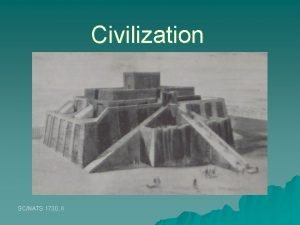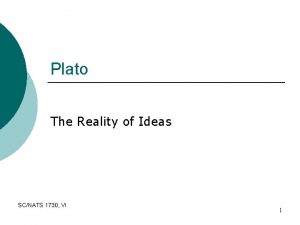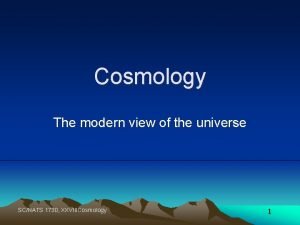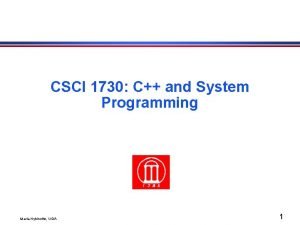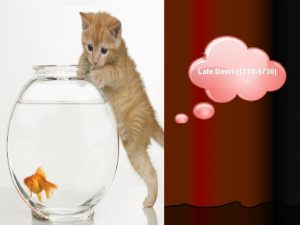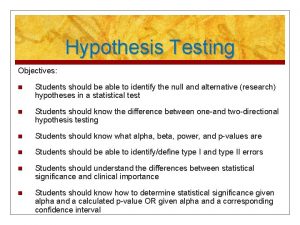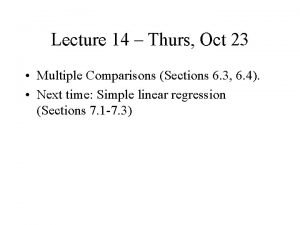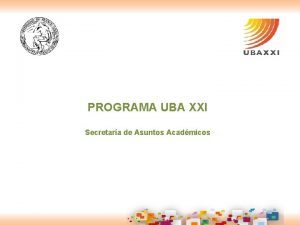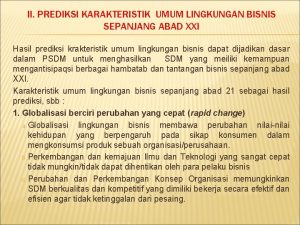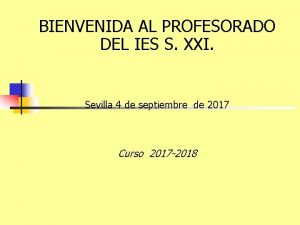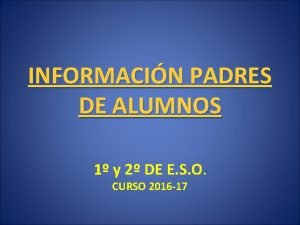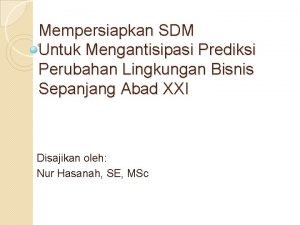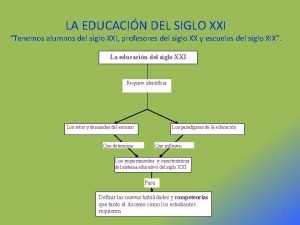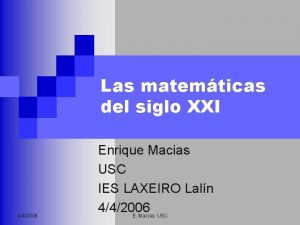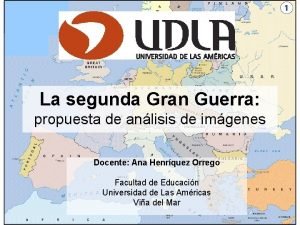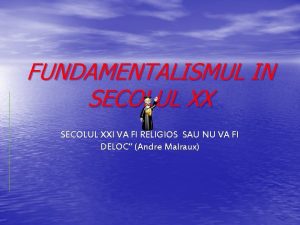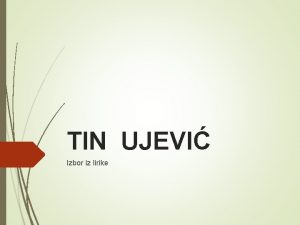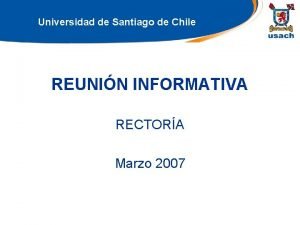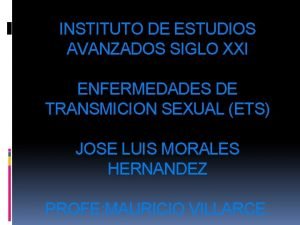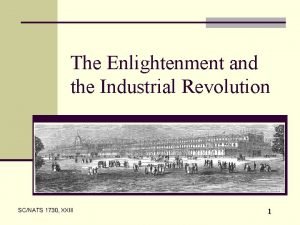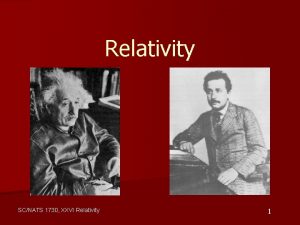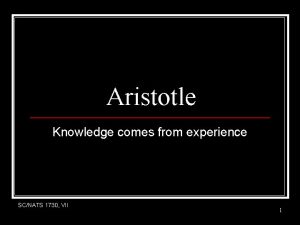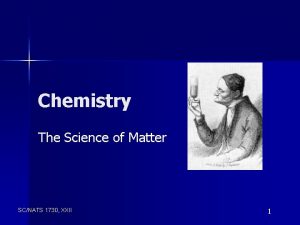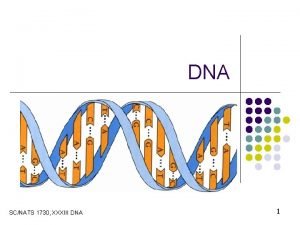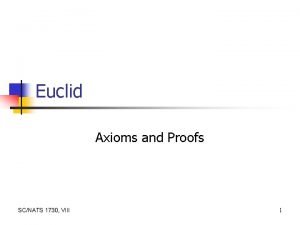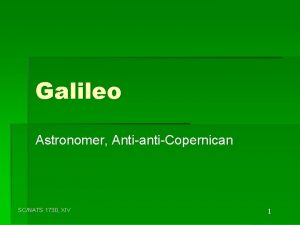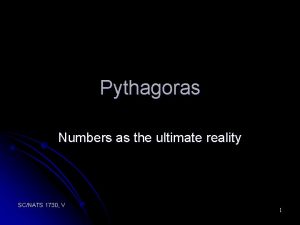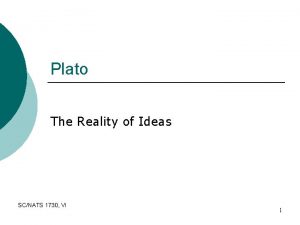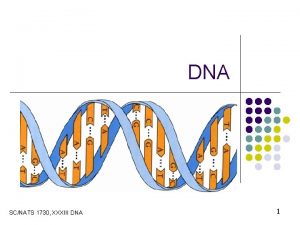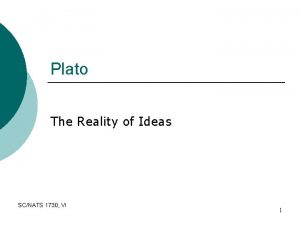Scientific Method Gaining the confidence SCNATS 1730 XXI












































- Slides: 44

Scientific Method Gaining the confidence SC/NATS 1730, XXI 1

Scientific Method n n How scientific discoveries are verified (and therefore become “discoveries”). The basis of confidence in hypotheses, supporting claims of knowledge. SC/NATS 1730, XXI 2

Types of Logical Reasoning n Induction: n n The forming of general statements from a number of particulars. Deduction: n The forming of statements (assertions) based on logical necessity. n A deduction can be a specific statement or a general conclusion. SC/NATS 1730, XXI 3

The empirical vs. the non-empirical sciences n Empirical sciences n n General statements are formed from inductions and then used to deduce consequences. All sciences of the natural world are empirical sciences. SC/NATS 1730, XXI Example: Galileo’s Law of Falling Bodies: d = 4. 9 m x t 2 Based upon measurements of actual bodies falling, or rolling, then generalized. 4

The empirical vs. the non-empirical sciences n Non-empirical sciences n n n Start with axioms and deduce all consequences. No reference to Example: Euclid’s Proposition I. 47 experience or (The Pythagorean Theorem). observation. Examples: logic and mathematics. SC/NATS 1730, XXI The conclusions depend only on the axioms and the validity of the logic that deduced them. 5

The Common Sense View of Science n Thomas Henry Huxley, prominent 19 th century British biologist, took the view that science is really just a refinement of ordinary common sense. n Huxley made many speeches to nonscientists explaining (and de-mystifying) science. SC/NATS 1730, XXI 6

Night school n In Britain after the invention of indoor gas lighting in the 19 th century, educational institutions sprang up offering lectures and night courses for working people. SC/NATS 1730, XXI 7

The Mechanics Institutes n The best known were the Mechanics Institutes, where many educational leaders came to give public lectures. SC/NATS 1730, XXI 8

Huxley at the Mechanics Institutes n At one, Huxley explained how scientific reasoning was just common sense. His illustrative examples follow…. SC/NATS 1730, XXI 9

Huxley’s apples: Explaining induction n n Suppose, says Huxley, that one goes to buy an apple and is handed one that is green. It also feels hard. On biting into it, it tastes sour. After repeating the same experience a number of times, one might reasonably conclude that ALL green, hard apples are sour. SC/NATS 1730, XXI 10

The principle of induction n n After noting several instances of essentially the same circumstances, always followed by the same result, we naturally form the general conclusion that those circumstances are always followed by that result. This, says Huxley, is a commonplace of everyday life and is how we learn to live in the world. SC/NATS 1730, XXI 11

Induction leads to possible deductions n n The person who suffered several green, hard apples that proved to be sour then learns a lesson and avoids green, hard apples in the future. That is, armed with the induction, it can be used as a premise in a deductive logical argument. SC/NATS 1730, XXI 12

The reasoning that avoids the next sour apple n A syllogism: n Major premise: n n Minor premise: n n This apple before me is green and hard. Conclusion: n n All green and hard apples are sour. This apple is sour. This, says Huxley, is the general form of of the scientific method. SC/NATS 1730, XXI 13

Choosing among different hypotheses n Preferring the probable and the consistent When several hypotheses can each account for the phenomena, the most probably one, or the one most consistent with other phenomena is to be favoured. n This is known as the principle of parsimony, choosing the simplest explanation that covers the evidence. n n Known also as Ockham’s Razor – introduced by William of Ockham in the 14 th century. SC/NATS 1730, XXI 14

Huxley’s homey example n On waking in the morning and coming downstairs, one finds the teapot and silverware missing, the window open, a dirty hand on the window frame, footprints in the gravel outside…. n n Many explanations are possible, but the evidence points strongly to a thief. This would be the reasonable conclusion. In general ad hoc explanations are to be avoided. SC/NATS 1730, XXI 15

Ad hoc hypotheses n n Ad hoc hypotheses are invented to fit the circumstances of the particular phenomenon to be explained. Unless they seem probable or are consistent with other phenomena (that appear independent of the case at hand), such hypotheses have little value. It is always possible to come up with an ad hoc explanation for any phenomenon. SC/NATS 1730, XXI 16

Examples of ad hoc arguments n Huxley’s missing teapot and silverware: n n Copernicus’ explanation of why Venus did not show phases: n n The argument that supernatural causes were responsible for the disappearances, e. g. that the teapot flew out of the window on its own accord, etc. He said Venus had its own light, like the Sun. Simplicus’ last ditch argument against the Copernican world view: n That God could make the heavens do whatever He pleased. SC/NATS 1730, XXI 17

The downside of the common sense view n While Huxley’s analysis covers many situations, science often comes to conclusions that are very much not common sense. n n E. g. , that the Earth is spinning around every day and hurtling through space around the sun. E. g. , universal gravitation – that every body that has mass attracts every other body that has mass with a force proportional to the product of their masses and inversely proportional to the square of the distance between them. SC/NATS 1730, XXI 18

Testing Hypotheses n n When an explanatory idea about nature is proposed, it remains a conjecture until it is verified one way or another. One of the key features of scientific method is systematic testing of hypotheses. SC/NATS 1730, XXI 19

Case study: Puerperal Fever n SC/NATS 1730, XXI A young obstetrician, Ignaz Semmelweis, working at the Vienna General Hospital in 1844 -1848 was concerned about the high incidence of death from puerperal fever in his patients and sought to understand its cause. 20

Puerperal fever n n Puerperal fever, also called childbed fever, is a virulent disease that attacks women shortly after childbirth, generally resulting is death in a few days. Its causes were unknown. Its incidence at Vienna General were especially high. SC/NATS 1730, XXI 21

General facts about pueperal fever in the Vienna General Hospital n There were two maternity divisions, the First, run by doctors, the Second, by midwives. Each had students working with them. n n The death rate from puerperal fever was much higher in the First Division than in the Second. “Street births, ” women who gave birth en route to the hospital general escaped getting the fever. SC/NATS 1730, XXI 22

Semmelweis sought all possible explanations n Semmelweis looked for every possible explanation why the fever should be higher in his ward and sought to eliminate them one by one. n Other than doctors versus midwives, there were few differences in diet or general care between the divisions. SC/NATS 1730, XXI 23

Focusing on the differences that there were n The differences that could be identified included: n Priests coming to deliver the last rites to the dying women were accompanied by an attendant ringing a bell. In the First Division, the priest walked through the wards to get to the patient. In the Second Division, priests used a side door and did not go through the wards. SC/NATS 1730, XXI 24

Other differences noted: Windows in the First Division opened out to the street. Those in the Second Division opened into an inner hallway. n In the First Division, women delivered babies on their backs. In the Second Division, the turned on their sides. n SC/NATS 1730, XXI 25

A built-in control group n Semmelweis sought to eliminate possible causes by changing practices in the First Division to match those in the Second. He changed the access route of the priests delivering last rites and eliminated the bell. n He closed the windows to the outside. n He had women in the First Division deliver babies on their sides. n SC/NATS 1730, XXI 26

Eliminating hypotheses through modus tollens n n The logical principle that Semmelweis employed has the name modus tollens. Modus tollens is a form of the syllogism that demonstrates that the major premise is inconsistent with the minor premise. n If the minor premise is known to be true, then the major premise must be false. SC/NATS 1730, XXI 27

Modus tollens as a tool in empirical science n Modus tollens is the essential logical tool to eliminate errors in empirical science. n If the major premise is an explanatory hypothesis and the minor premise is a set of observed facts, modus tollens can be used to show that the hypothesis must be false and therefore must be discarded. SC/NATS 1730, XXI 28

Semmelweis and modus tollens n Semmelweis showed that changing the routine of the priests made no difference to the puerperal fever rate. n n Neither did closing the windows, nor having women deliver on their sides. Since none of these made any difference, these were not the causes. SC/NATS 1730, XXI 29

The modus tollens syllogism n n n Call the hypothesis H. The hypothesis will have an observable implication, I. Major premise: n n Minor premise (the observation): n n If H is true, then so is I. I is false. Conclusion: n H is false. SC/NATS 1730, XXI 30

A key point n Modus tollens is only useful for eliminating a hypothesis. The proposed explanation H implies that the observable fact I will be true. n If I is not true (e. g. the puerperal fever rate did not go down), then something is wrong with the explanation. n n But if I is true, the hypothesis is not proven. SC/NATS 1730, XXI 31

New evidence for Semmelweis n After coming up empty handed on finding the cause of the fever, a freak accident gave Semmelweis a new idea. n His colleague, Kolletschka, died in a few days after receiving a puncture wound from a scalpel while doing an autopsy. Kolletschka displayed symptoms similar to puerperal fever during his brief illness. SC/NATS 1730, XXI 32

Cadaveric matter n n Semmelweis hypothesized that Kolletschka was killed by the “cadaveric matter” introduced into his body by the scalpel, and that perhaps his female patients are similarly infected by “cadaveric matter” when being examined by medical students who have come from doing autopsies. Semmelweis formulates a new hypothesis and a test for its validity. SC/NATS 1730, XXI 33

The hypothesis and its test implication n Hypothesis: n n H = Cadaveric matter entering the bodies of women induce puerperal fever. Test implication: n I = If medical students wash their hands thoroughly in a solution of chlorinated lime to remove all traces of cadaveric matter before examining women in the maternity ward, incidences of puerperal fever will drop off dramatically. SC/NATS 1730, XXI 34

Applying the test n Semmelweis ordered medical students and doctors to use the chlorinated lime solution when coming from the autopsy room. SC/NATS 1730, XXI 35

Interpreting the test n n The incidence of puerperal fever in the First Division promptly fell to a rate lower than that of the Second Division. Eureka? SC/NATS 1730, XXI 36

Further confirmation n Later, when his instructions were not followed, the incidence rose again, but was halted when washing with chlorinated line was resumed. Semmelweis believed he had found the cause of the disease. Was he justified in believing so? SC/NATS 1730, XXI 37

The Error of Semmelweis n n Semmelweis believed that cadaveric matter (i. e. , bits of corpses) was the only cause of puerperal fever. His reasoning: n Bits of dead bodies cause the infection. Eliminate the cadaveric matter no infection. SC/NATS 1730, XXI 38

A troubling unexpected case n n n A woman had been admitted with cervical cancer and had been placed in the maternity ward. She had been examined by the doctors and students, who then went on to examine the other women in the ward, without washing their hands. All the other women in the ward developed puerperal fever. SC/NATS 1730, XXI 39

The hypothesis, H, was too restrictive n Semmelweis had believed that only matter from corpses conveyed the infection. He had not considered that the problem was putrefaction. n There was no theory of microbes at the time. Disease was not understood to be caused by bacterial infection, since bacteria were basically unknown. SC/NATS 1730, XXI 40

The Fallacy of Affirming the Consequent n Semmelweis had unwittingly committed a logical fallacy, known as the fallacy of affirming the consequent. n The form of the fallacy: If H is true, then so is I. n I is true. n False conclusion: H is true. n SC/NATS 1730, XXI 41

Semmelweis’ fallacy n n n His implication, I , was that washing the hands after doing autopsies will prevent the fever. His hypothesis, H, was that cadaveric matter was the sole cause of the fever. But the reasoning is fallacious because I can be true when H is false. n E. g. , apples that are not green and hard can also be sour. SC/NATS 1730, XXI 42

Falsification n n It is an inescapable feature of empirical science that a hypothesis, or a theory, can never be fully verified as true. It is possible to show that a hypothesis is false (using modus tollens), but not to be true. SC/NATS 1730, XXI 43

Confirmation n n The best that can be done is to confirm that a hypothesis is consistent with other hypotheses and theories, and has many true implications, and therefore, probably, is true as far as we know. The logical form of confirmation: n n n If H is true, then so are I 1, I 2, I 3, …, In. Evidence shows that I 1, I 2, I 3, …, In are all true. Conclusion: H is probably true. SC/NATS 1730, XXI 44
 Scnats
Scnats Scnats
Scnats Scnats
Scnats Csci 1730
Csci 1730 1718 1730
1718 1730 Lale devri slayt
Lale devri slayt Confidence interval vs confidence level
Confidence interval vs confidence level 96 confidence interval z score
96 confidence interval z score Scientific inquiry vs scientific method
Scientific inquiry vs scientific method How is a scientific law different from a scientific theory?
How is a scientific law different from a scientific theory? Tukey multiple comparison method confidence interval
Tukey multiple comparison method confidence interval Purpose of symposium
Purpose of symposium Salud publica siglo xxi
Salud publica siglo xxi Claves de corrección uba xxi
Claves de corrección uba xxi Karakteristik lingkungan bisnis abad 21
Karakteristik lingkungan bisnis abad 21 Gimnasio siglo 21 zaragoza
Gimnasio siglo 21 zaragoza Ies siglo xxi sevilla opiniones
Ies siglo xxi sevilla opiniones Wynalazki 21 wieku prezentacja
Wynalazki 21 wieku prezentacja Mirador xxi padres
Mirador xxi padres Com se an/uyk-128a(v)3
Com se an/uyk-128a(v)3 Perfil del docente del siglo xxi
Perfil del docente del siglo xxi Energy xxi
Energy xxi Persiapan sdm mengantisipasi perubahan lingkungan bisnis
Persiapan sdm mengantisipasi perubahan lingkungan bisnis Cualidades del docente del siglo xxi
Cualidades del docente del siglo xxi Siglo xxi lalin
Siglo xxi lalin Vertical y horizontal
Vertical y horizontal Secolul 21 va fi religios sau nu va fi deloc
Secolul 21 va fi religios sau nu va fi deloc Lelek sebra značenje
Lelek sebra značenje Puntajes psu 2007
Puntajes psu 2007 La sociedad del siglo xxi, nuevos paradigmas de familia
La sociedad del siglo xxi, nuevos paradigmas de familia Instituto de estudios avanzados siglo xxi
Instituto de estudios avanzados siglo xxi Hát kết hợp bộ gõ cơ thể
Hát kết hợp bộ gõ cơ thể Bổ thể
Bổ thể Tỉ lệ cơ thể trẻ em
Tỉ lệ cơ thể trẻ em Chó sói
Chó sói Chụp phim tư thế worms-breton
Chụp phim tư thế worms-breton Hát lên người ơi alleluia
Hát lên người ơi alleluia Môn thể thao bắt đầu bằng từ chạy
Môn thể thao bắt đầu bằng từ chạy Thế nào là hệ số cao nhất
Thế nào là hệ số cao nhất Các châu lục và đại dương trên thế giới
Các châu lục và đại dương trên thế giới Cong thức tính động năng
Cong thức tính động năng Trời xanh đây là của chúng ta thể thơ
Trời xanh đây là của chúng ta thể thơ Mật thư anh em như thể tay chân
Mật thư anh em như thể tay chân 101012 bằng
101012 bằng
